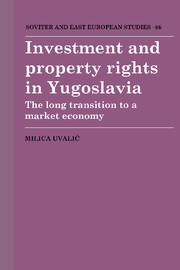Book contents
- Frontmatter
- Contents
- List of figures
- List of tables
- Preface and acknowledgements
- Introduction
- Part I The institutional and theoretical framework
- 1 The Yugoslav road towards market socialism
- 2 The investment theory of the labour-managed firm
- 3 Extensions of the LMF investment theory
- 4 The investment behaviour of the socialist firm
- Part II Empirical evidence on the nature of the Yugoslav system
- Part III Pressure for more radical reforms in Yugoslavia
- Notes
- List of references
- Index
- Series list
3 - Extensions of the LMF investment theory
Published online by Cambridge University Press: 11 January 2010
- Frontmatter
- Contents
- List of figures
- List of tables
- Preface and acknowledgements
- Introduction
- Part I The institutional and theoretical framework
- 1 The Yugoslav road towards market socialism
- 2 The investment theory of the labour-managed firm
- 3 Extensions of the LMF investment theory
- 4 The investment behaviour of the socialist firm
- Part II Empirical evidence on the nature of the Yugoslav system
- Part III Pressure for more radical reforms in Yugoslavia
- Notes
- List of references
- Index
- Series list
Summary
The Vanek-Furubotn-Pejovich hypothesis has laid down the basis for analysis of LMF investment behaviour and even today, after twenty years, it represents the dominant theory. Nevertheless, the conclusion on underinvestment cannot be generalized, as critical assessments of the theory have proposed conditions under which an LMF may not underinvest. Four groups of considerations are of particular importance, related to restrictions on capital withdrawals, the planning horizon, methods of finance, and some other critical assumptions.
A differentiation of restrictions
The collective nature of investment in an LMF can have different implications, depending on the type of restrictions regarding capital withdrawals. It can imply the limited recovery of capital (LRC), which prohibits withdrawals of workers' shares in past investment and the capitalization of future earnings, in case a worker leaves the firm; and the capital maintenance requirement (CMR), which requires refinancing of past investment through appropriate depreciation in order to maintain the value of enterprise assets. While the CMR is usually taken to represent the Yugoslav LMF, the LRC is considered a general characteristic of the LMF with collective ownership. Since both sets of rules imply a limitation of traditionally conceived capitalist property rights, they have often been considered jointly in the literature under the generic term of ‘limited recovery of capital’. It has been argued that the disincentive to invest can only be established unambiguously under the CMR, i.e. if the LMF is obliged to maintain its capital stock indefinitely (Zafiris 1982; Uvalić 1986).
- Type
- Chapter
- Information
- Investment and Property Rights in YugoslaviaThe Long Transition to a Market Economy, pp. 29 - 53Publisher: Cambridge University PressPrint publication year: 1992

